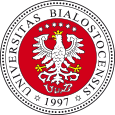Seminarium wydziałowe
Dnia 2019-03-05 o godzinie 13:15 w sali 2011 Wydziału Fizyki UwB odbędzie się wykład, na którym dr Piotr Kuświk z Instytutu Fizyki Molekularnej PAN wygłosi wykład pt:
” Spin chirality in exchange biased thin layered system”
Serdecznie zapraszamy
Andrzej Maziewski
Jerzy Przeszowski
Spin chirality in exchange biased thin layered systems
Piotr Kuświk (Institute of Molecular Physics, Polish Academy of Sciences, Poznań, Poland )
Nowadays, the spin chirality is being widely investigated in magnetic materials, because it opens a new perspective to fabricate materials, which can be suitable for application in high-density information storage and logic circuits. The most extensive studies were carried out for magnetic thin films with broken inversion symmetry, where the spin chirality is tailored by the interfacial Dzyaloshinskii-Moriya interaction (iDMI) [1]. This interaction in systems with perpendicular magnetic anisotropy (PMA) (magnetization direction is oriented perpendicular to the surface plane) may stabilize chiral Néel-type domain walls (walls with spin rotation in a plane perpendicular to the surface of the domain wall) or skyrmions (nanometers sizes topological protected chiral spin configuration). Therefore, a lot of attention is paid to tune the strength and sign of iDMI, in particular in ferromagnetic(F)/heavy metal(HM) multilayers or HM/F/nonmagnetic oxide systems, where it was found that Néel domain wall or skyrmion can be moved with high speed by the electric current [1]. In light of recent result [3], the skyrmions can be stabilized at room temperature by perpendicular exchange bias in HM/F/antiferromagnetic(AF) systems without any external magnetic field, which is an important step forward in the skyrmion-based application.
Therefore, here we focused to investigate the Au(HM)/Co(F)/NiO(AF) layered system, where we found that the NiO layer drives the magnetization of the Co layer to be oriented perpendicularly to the sample plane due the exchange bias coupling between Co and NiO spins [4]. As a consequence, the spin reorientation transition from out-of-plane to easy-plane occurs for much thicker Co layer when the Co layer is covered with NiO layer as compared to covered with Au. Due to symmetry breaking of the Co interfaces this system shows iDMI and the use of antiferromagnetic layers allows to obtain significant perpendicular exchange bias field [5,6], which can be tuned by ion bombardment without using the field cooling procedure [7]. Using polar magneto-optical Kerr effect measurements we showed that in such system the Néel domain walls with clockwise chirality are stabilized by a strong negative iDMI [5], which is independent of the direction of perpendicular exchange bias coupling [6]. Additionally, we demonstrated that due to this spin configuration in DWs the domain propagation can be controlled with high precision by homogeneous external magnetic fields simultaneously applied out-of-plane and in-plane [5]. This concept can be attractive for many applications based on field-induced domain motion.
[1] A. Fert et al., Nature Materials 2, 17031 (2017)
[2] A. Fert et al., Nature Nanotechnology 8, 152 (2013)
[3] G. Yu, et al., Nano Lett. 18, 980 (2018)
[4] P. Kuświk et al., J. Appl. Phys. 119, 215307 (2016)
[5] P. Kuświk et al., Phys. Rev. B 97, 024404 (2018)
[6] P. Kuświk et al., J. Mag. Mag. Mat. 472, 29 (2019)
[7] P. Kuświk et al., Nanomaterials 8, 813
